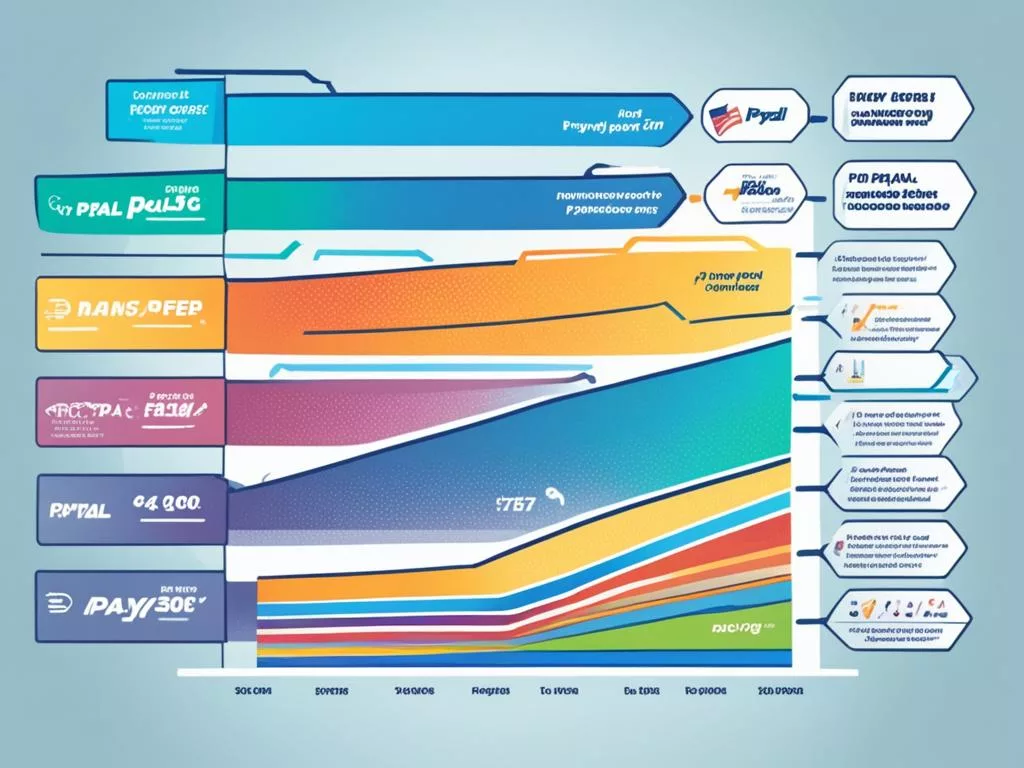I’ve been a freelancer for a while and know that PayPal’s fees can really add up. By using money right from my PayPal, I avoid extra bank costs1. Learning about PayPal’s 1.5% fee for money conversion was a game-changer for me1. And remember, a domestic transaction in the U.S. has a fee of 2.9% plus $0.301 while instant withdrawals to a bank or card have a fixed 1% fee1.
Grouping work payments into bigger amounts lowered the fees I face1. Keeping up with PayPal’s fee changes is a must for saving money1. I also use PayPal Here for in-person sales, which only has a 2.7% fee1.
One trick I use is linking a US bank to PayPal to sidestep debit card fees1. PayPal’s huge global reach, with over 200 countries and 325 million users, is hard to ignore2. I always compare PayPal’s rates with others to get the best deal. Knowing about high exchange rate markups, from 2.9% to 5%, helps me budget for international work2.
When dealing with PayPal fees next time, remember these tips to keep more cash for yourself. My tactics might not avoid all currency conversion fees, which can be 3-4%, but they soften the impact1. Making bigger transactions and skipping quick, costly withdrawals helps me focus on growing my business. Every dollar saved on fees is a dollar towards my financial dreams.
Understanding PayPal’s Fee Structure for International Transactions
PayPal is big in international transactions, holding a 39.06% market share3. This shows it’s a top choice for many around the world. When dealing with currencies different from your own, PayPal charges a 4% fee for the conversion3.
Sellers face many fees, from 2.29% to 3.49% plus a fixed fee, depending on the payment method3. For credit and debit card payments, the fee jumps to 2.99% plus a specific fixed charge3. However, PayPal doesn’t charge for transactions in your home currency or when sending money to friends and family in your country3.
To cut down on conversion fees, consider using Wise4. Here, you can skip the currency conversion fees and only pay a small, clear fee. Wise also offers a mid-market exchange rate, making it attractive for business accounts thanks to perks like no monthly charges and payments in batches4.
- PayPal charges up to 4% for currency conversion3
- Merchants incur varying fees based on payment methods3
- No fees within home currency or for personal transfers3
- Wise potentially minimizes international transaction fees4

PayPal takes a 5% fee for transactions through cards, bank accounts, or Amex Send accounts4. It has different exchange rates for balance and payment transfers, usually favoring the former4.
| Service | Market Share | Currency Conversion Fee | Typical Transaction Fee |
|---|---|---|---|
| PayPal | 39.06%3 | 3% – 4%4 | 2.29% – 3.49% + Fixed Fee3 |
| Stripe | 36.82%3 | N/A | N/A |
| Wise | Not specified | Low and transparent fee4 | No monthly fees, batch payments4 |
Finding ways to cut international transaction fees is key. Looking closely at PayPal’s fees and considering alternatives like Wise is smart. This approach helps save on fees, boosting your business’s cash flow and financial freedom.
Guide to reduce PayPal conversion fees tricks save money exchange money
I often use PayPal for my transactions and always search for ways to cut costs. One effective method I use is to minimize conversion fees. Here’s how:
- I make sure to fund transactions directly from my PayPal balance instead of using a card. This trick saves me from extra fees.
- Paying in larger amounts is also smart because PayPal’s fees max out at $4.99. By grouping payments, I save more.
- For my business, I factor in PayPal costs, especially for deals across borders. This way, I’m never surprised by conversion fees.
The Tipalti PayPal Fee Calculator is my go-to for figuring out transaction fees. It really helps me plan my payments and keep fees low.

I’ve tested these methods in my own dealings, and they work well. Watching for ways to save with PayPal is now part of my routine. I suggest others do the same to protect their earnings.
Strategic Payment Tactics to Save on PayPal Fees
Accepting payments from other countries can really grow your business. But, it’s key to use PayPal smartly5. For example, letting folks pay in their own money has made my customers happier and more loyal5. This, in turn, means they’re more likely to buy. But, the fees PayPal charges for global payments can eat into profits5. By keeping different currencies in PayPal, I have more control over when to exchange money5. This avoids unnecessary costs.
Also, using geolocation to show prices in the local currency has been a big help6. It makes shopping easier for customers and can help reduce the number of people who leave without buying6. With PayPal, I can accept money in 21 currencies, making everything smoother5. And, good accounting software is crucial for tracking money across different currencies5.
I always check PayPal’s conversion rates because they can be high. For instance, converting €1000 could cost $33 with PayPal, but only $6.82 with Wise7. So, looking for better deals can save a lot of money7. Plus, good record-keeping makes sure PayPal fees are counted as business costs7. This could lower your taxes, which is an added perk.
Source Links
- https://www.freshbooks.com/hub/payments/does-paypal-charge-a-fee
- https://www.finder.com/international-money-transfers/paypal-international-money-transfers
- https://www.investopedia.com/terms/p/paypal.asp
- https://wise.com/us/blog/paypal-currency-conversion-rates
- https://www.paypal.com/us/brc/article/how-to-accept-foreign-currency-with-your-business-account
- https://www.paypal.com/us/brc/article/increase-conversions-on-your-online-store
- https://wise.com/us/blog/paypal-invoice-fee

